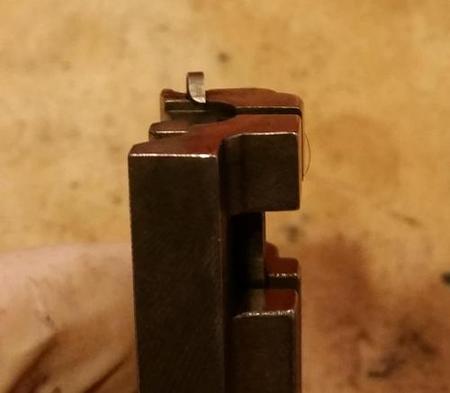Does this extractor look worn?

You can see the bottom edge is rounded on it (bottom left side as shown in picture).
I've been having some ejection issues lately. Seems like it started few months ago at a Winterseed event - I was getting lots of stovepipes or spent cases otherwise not fully ejecting, and usually the next round did get inserted in to the chamber/barrel. Figured maybe it was just snow/ice.
Shot it once again after that (and after cleaning thoroughly) with the same box of ammo and still had several FTEs. Ammo was Federal Automatch bulk pack. I'm pretty sure I had shot with that brand of ammo before with no issues though.
Shot it again today, with some .22 Thunderbolt and some Winchester bulk pack hollow points.... didn't have any problems with the thunderbolt but had a couple FTEs with the winchester....
I think the thunderbolts are a little more powerful, so I guess it would make sense they would be less susceptible to having ejection issues.
But, regardless of ammo differences, I'm curious if that extractor looking like its worn could really be the cause of the ejection issues?

You can see the bottom edge is rounded on it (bottom left side as shown in picture).
I've been having some ejection issues lately. Seems like it started few months ago at a Winterseed event - I was getting lots of stovepipes or spent cases otherwise not fully ejecting, and usually the next round did get inserted in to the chamber/barrel. Figured maybe it was just snow/ice.
Shot it once again after that (and after cleaning thoroughly) with the same box of ammo and still had several FTEs. Ammo was Federal Automatch bulk pack. I'm pretty sure I had shot with that brand of ammo before with no issues though.
Shot it again today, with some .22 Thunderbolt and some Winchester bulk pack hollow points.... didn't have any problems with the thunderbolt but had a couple FTEs with the winchester....
I think the thunderbolts are a little more powerful, so I guess it would make sense they would be less susceptible to having ejection issues.
But, regardless of ammo differences, I'm curious if that extractor looking like its worn could really be the cause of the ejection issues?


![Smile [smile] [smile]](/xen/styles/default/xenforo/smilies.vb/001.gif)